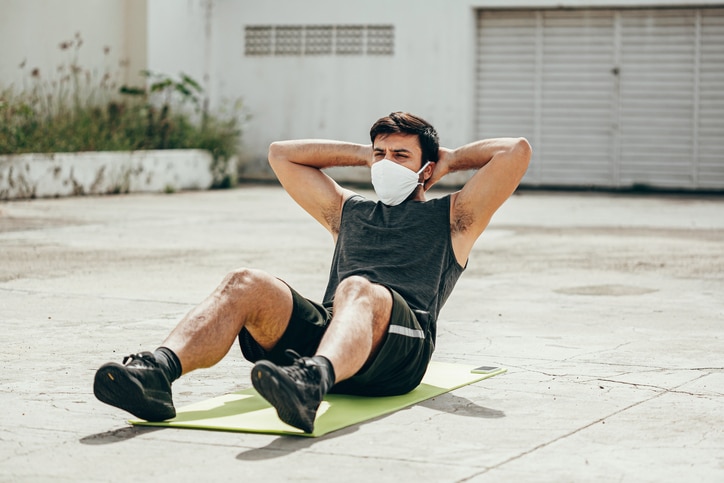Let’s face it… Wearing a face mask is a pain.
They are hot, stuffy, and uncomfortable. And when you exercise and start breathing heavier, things only get worse.
But many of us have no choice but to wear them during workouts.
Almost all gyms require them. And some cities mandate them even for outdoor exercise done in public spaces such as parks or jogging trails.
There’s a reason for this…
Masks may be more important during exercise than for any other activity. That’s because your breathing rate can double or even quadruple during aerobic workouts. That means you are breathing in and sending out far higher amounts of potentially infectious respiratory droplets.
What you may not know is that mask wearing has physical effects that go beyond germ protection.
A recent article in the British Journal of Sports Medicine points out that exercising with a mask is about “balancing benefits versus adverse events.”[1]
Large-scale studies on the subject are impossible because it would be unethical to ask people to go without a mask during the pandemic. But some scientists have begun testing mask wearing by using themselves and colleagues as guinea pigs.
Dr. Cedric X. Bryant is the president and chief science officer of the American Council on Exercise. He said that the number one effect of wearing a mask while exercising is that it makes your heart beat faster.[2]
The same level of exertion will push your heart rate higher when you’re wearing a mask compared to being maskless.
“You should anticipate that (with masked exercise) it will be about eight to 10 beats higher per minute,” said Dr. Bryant.
You’ll likely also find that you get out of breath faster, he said.
Lightheadedness is another possible result of masked exercise, said Professor Len Kravitz of the University of New Mexico. He ran an informal experiment with two students. Both ran wearing the same kind of cloth mask. One didn’t have any problems. The other felt dizzy after just a few minutes of exertion.
Grayson Wickham is a physical therapist and certified strength and conditioning specialist. He believes that, despite the difficulties, exercising with a mask is generally safe.[3]
“Most people can perform every and all exercises with a face mask on,” he said.
Exceptions include people with serious underlying heart or respiratory issues. They should exercise away from other people without a face mask. His advice applies to people with cystic fibrosis, pulmonary fibrosis, COPD, bronchitis, and other heart or lung conditions.
The first time you wear a mask while exercising, you should take it slow in the beginning. “Monitor how you’re feeling,” he said, watching out for signs of dizziness, numbness, tingling, or unusual shortness of breath.
Wearing a mask will decrease air flow into your lungs. That means you absorb less oxygen, said Scott McAfee. He’s a physical therapist and orthopedic specialist.[4]
“With less air, your body has less available oxygen to utilize during exercise to convert glucose into energy,” he said. When wearing a mask, you will tire faster than normal.
“If you start to feel dizzy, imbalanced, or overly fatigued, stop. Be smart… Don’t overdo it,” McAfee said.
5 Ways to Make Exercising With a Mask Easier
Here’s how to minimize the difficulties of working out with a mask:
- Avoid paper or cotton masks. Christa Janse van Rensburg is a professor of exercise science. She said paper masks become damp easily when you’re breathing hard. That can make them less effective at blocking the virus. The same holds true for cotton masks.[5]
Masks made with synthetic fabrics are better. But make sure they have no more than two layers. A thicker mask will be more uncomfortable and can restrict breathing to the point that exercise is difficult. - Carry extras. That way you can replace your mask if it becomes wet from hard breathing or damp weather.
- Use a buff. It’s a tube of lightweight, stretchy material. It covers your neck and can be pulled up over your mouth and nose. They are made from shear material that is easy to breathe through. They’re often more comfortable than a regular mask, but “perhaps with the trade-off of less effective infection control,” said Professor Rensburg.
- Use masks designed for exercise. Some athletic retailers are starting to make masks specifically intended for use while exercising. These include Under Armour, Zensah, and Koral.
- Exercise regularly. The more you work out with a mask, the easier it gets. “Over a few weeks, your body will certainly adapt by becoming more efficient at metabolizing oxygen,” said McAfee.
Wearing a face mask is no fun, especially while exercising. But knowing what to expect and taking steps to minimize the discomfort will help you stay in shape during the pandemic.
Editor’s Note: Discover the single best supplement for stronger immunity… The fruit extract that helps 93% of people with respiratory viruses get better in just two days… The germ hotspot that most of us forget to sanitize. Find all this and more in Independent Healing’s Coronavirus Pandemic Guide. Go HERE.
Related Articles
Coronavirus Doesn’t Spread the Way You Think
Coronavirus Stress: 5 Ways to Keep Calm and Carry On
9 Coronavirus Symptoms You Should Watch For
Like this Article? Forward this article here or Share on Facebook.
[1]https://blogs.bmj.com/bjsm/2020/06/12/should-people-wear-a-face-mask-during-exercise-what-should-clinicians-advise/
[2]https://www.nytimes.com/2020/06/17/well/move/exercising-while-wearing-a-mask.html
[3]https://www.cnet.com/health/how-to-exercise-with-a-face-mask/
[4]https://www.cnet.com/health/how-to-exercise-with-a-face-mask/
[5]https://www.nytimes.com/2020/06/17/well/move/exercising-while-wearing-a-mask.html

